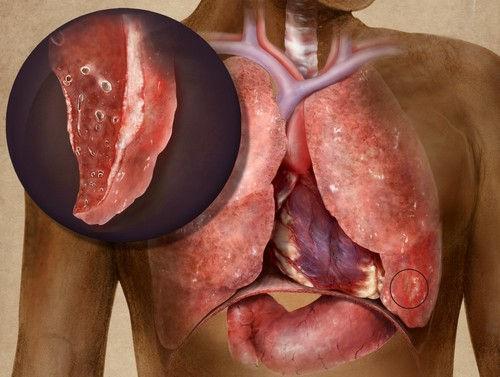Mesothelioma pleura

Mesothelioma pleura – the only known malignant pleural disease, almost all cases of mesothelioma caused by asbestos exposure. The lifetime risk of developing the disease in people who work with asbestos, is approximately 10%, with a mean latency of 30 years. It does not depend on the risk of smoking. Mesothelioma can spread locally or metastasize to the pericardium, diaphragm, peritoneum, and, rarely, in the tunica vaginalis testis.
The symptoms of pleural mesothelioma
Patients often say neplevriticheskuyu shortness of breath and chest pain. Symptoms of pleural mesothelioma, showing the generalization of the process, rare in the clinical manifestation of the disease. Invasion of the chest wall and other adjacent structures can cause severe pain, dysphonia, dysphagia, Horner’s syndrome, brachial plexopathy, or ascites. Extrathoracic spread is found in 80% of patients, usually including the lymph nodes of roots and mediastinum, liver, adrenal glands and kidneys.
Diagnosis of pleural mesothelioma
Pleural form of mesothelioma, which is more than 90% of all cases detected on the radiograph as diffuse unilateral or bilateral pleural thickening, which is as it covers the lungs, usually leading to an increase in edge-phrenic angles. Pleural effusion is present in 95% of cases and is usually unilateral, massive. Diagnosis is based on the cytology of pleural fluid or pleural biopsy and, if they are nondiagnostic biopsies at Video-thoracoscopy (Watsu), or thoracotomy. Staging is performed using chest CT, mediastinoscopy and NMR. The sensitivity and specificity of CT and NMR comparable, although useful for NMR determination of tumor spread in the spine or spinal cord. PET may have the best sensitivity and specificity for the differential diagnosis of benign and malignant pleural thickening. Bronchoscopy reveals related endobronchial malignant tumors. Elevated levels of hyaluronidase in the pleural liquid is suspicious, but not diagnostic for the disease. Soluble mezotelin-related proteins secreted in serum mesothelial cells are being studied as potential tumor markers for the detection and monitoring of disease.
The treatment of pleural mesothelioma
Pleural mesothelioma is incurable cancer. Surgery to remove the pleura; unilateral pneumonectomy, removing half of the phrenic nerve and the diaphragm; removal of the pericardium with chemotherapy or radiation therapy are considered as possible methods of treatment, but they do not substantially alter the terms of survival or prognosis; long-term survival is rare. Furthermore, complete surgical resection is not feasible in most patients. The combination of pemetrexed (antifolate antimetabolite) and cisplatin give encouraging results, but requires further investigation.
The main goal of maintenance therapy is to reduce pain and shortness of breath. Given the diffuse nature of the disease is not usually possible radiotherapy except indications for treating local pain and metastases, but should not be used for the treatment of radicular pain. To reduce the shortness of breath caused by pleural effusion, can be used pleurodesis or pleurectomy. Adequate analgesia is hard, but it must achieve, typically using opioids using both transdermal and epidural catheters for pain control. Cisplatin chemotherapy using gemcitabine reduces symptoms of pleural mesothelioma in most cases and demonstrates the reduction in tumor patients studied half. Some authors suggest a multimodal treatment of pleural mesothelioma. Intrapleural administration of granulocyte-macrophage colony stimulating factor and interferon gamma, intravenous ranpirnazy (ribonuclease) and gene therapy are at the research stage.
What is the prognosis of pleural mesothelioma is?
Pleural mesothelioma has a poor prognosis. No treatment of pleural mesothelioma has not shown a significant increase in life expectancy. The survival time from diagnosis is 8-15 months, on average, depending on the cell type and location. A small number of patients, generally younger having a shorter duration of symptoms are more favorable prognosis sometimes remain alive for several years after diagnosis.













